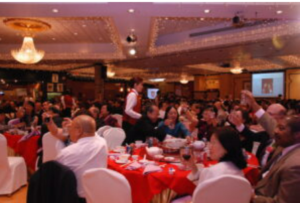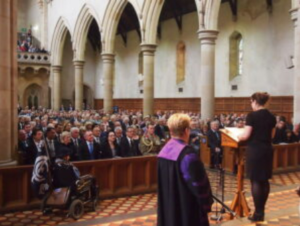Speeches about Other People: Toasts, Roasts, and Eulogies
Toasts, roasts, and eulogies are public speaking situations that call for thoughtfulness and care. In each of these situations, you’re trying to honor someone through your words, while creating an emotional connection to the crowd. You may be entertaining the crowd in an uproarious roast, creating a festive mood with a toast at a banquet, or comforting grieving family and friends with a heartfelt eulogy. Knowing how to deliver speeches for each of these situations will serve you for a lifetime.
Toasts

Toasts are celebratory. At many formal dinners or dinner gatherings, it may be expected to give toasts. The nature of these toasts will be different depending on the situation, but what they have in common is that you say them while holding up a glass (and usually while your audience does too), which means that a toast should be short.
Different cultures and contexts may have various customs around toasts. For instance, in some cultures it’s important to look people in the eye while clinking glasses. In others, one should drink everything in one’s glass after the toast. Some avoid toasting with water. And so on. If you’re at a formal dinner, it’s a good idea to know what the toasting protocols might involve.
Usually, toasts end with some kind of wish for the future, such as “May you live for as long as you want, and never want for as long as you live!” If you find yourself at a lot of formal dinners, it can be wise to memorize a go-to toast or two, whether heartfelt (“May your house always be too small to hold all our friends”) or humorous (“May your children have wealthy parents”).
Wedding Toasts

Wedding toasts often loom large in our imagination as we think about public speaking situations. This perception might be because wedding toasts represent a distinctive (and potentially intimidating) combination of the elements of public speaking:
Audience
At a wedding, the audience is usually highly varied and diverse, from young children to great-grandparents. Some audience members have known the couple for years, others are distant relatives, co-workers, or guests of friends or relatives. We know that it’s important to tailor a speech to the audience, so how do you do that if the audience is so varied? The answer, in this case, is that this diverse audience has one thing in common: a connection to the couple being married. So that connection should be your starting point. The other elements, such as differences in age and worldview, should act as guardrails for the content of the toast. Should you tell that hilarious but not-safe-for-work joke? Not while Aunt Ethel’s there. Is this a good time to give a fiery political speech? Probably not, considering how Grandpa Jake will react.
Context
One of the trickiest tensions to negotiate in a wedding toast is the mix of tradition and individualism that goes into any wedding. Most weddings have some element of tradition in their structure or substance. If you’re asked to speak at a wedding, it’s a good idea to get a sense of how traditional the wedding is intended to be and which traditions it’s drawing from. The most important thing to notice about “traditional” wedding toast order is that it ensures that everyone is recognized and thanked. Before preparing your speech, you should find out if there’s a particular person or group at the wedding you should acknowledge with your toast.
Content
The content of your toast will depend on your role in the wedding, your relationship to the couple, the amount of time you have available, and the nature of the wedding. However, don’t be fooled into thinking that a casual wedding is a place for unrehearsed remarks. Public speech, even impromptu public speech, is always more effective with some structure. Your toast should still have an introduction, body, and conclusion.
-
Introduction: Introduce yourself. Then start your lead-in. You can start with a joke or a funny anecdote, though be sure to pay attention to the appropriateness of your humor for the crowd. You may use self-deprecating humor, or meta-humor, which is humor that makes a joke about making a joke. You can also say something sincere or heartfelt; a wedding toast doesn’t have to be funny, but it does have to be genuine.
-
Body: Here’s where you need to think about the message you’re trying to get across. What do you want this audience to know about these people? When preparing your toast, brainstorm qualities or characteristics of the couple that you want to communicate. When you’ve chosen a few top qualities, think in terms of evidence. If you say the couple is kind and thoughtful, what are examples of that? Is there a story you can tell? Make sure you talk about both of the people being married, even if you know one of them better than the other. Stories and anecdotes are often the body of a wedding toast, but remember that they are there as supporting material to prove your claim, that these excellent people are great for each other and have the love and support of their family and friends.
-
 Conclusion: In a toast, the conclusion is the easiest part, since it’s the toast part. Raise your glass and saying something like, “Now lets all raise our glasses to. . . .” Many toasts include a wish for the future, such as “may your life together be full of love and laughter.” You can also use a quote here or tie the toast back into the themes of your speech. The most important thing is to be sincere, complimentary, and uplifting at the end of the speech.
Conclusion: In a toast, the conclusion is the easiest part, since it’s the toast part. Raise your glass and saying something like, “Now lets all raise our glasses to. . . .” Many toasts include a wish for the future, such as “may your life together be full of love and laughter.” You can also use a quote here or tie the toast back into the themes of your speech. The most important thing is to be sincere, complimentary, and uplifting at the end of the speech.
Since wedding toasts take place among a lot of other moving parts, it’s key to start and finish as seamlessly as possible. When it’s your turn to speak, be ready to go without hesitation or technical difficulties. You may be using a microphone, in which case you should try to test it out beforehand if possible to find the right volume and distance. Above all, practice before the event! It’s usually best to speak extemporaneously, memorizing only the key points of the speech and any lines that need to be delivered word for word (such as quotes).
The following video provides an example of a wedding toast.
You can view the transcript for “The BEST (worst) Wedding Toast EVER!” here (opens in new window).
What to watch for:
In this wedding toast, Conroy sticks to a winning formula:
- Some gentle jokes, largely self-deprecating, with some meta-humor about bad wedding-speech jokes
- A story about how the couple met
- Complimentary words about the characteristics of the couple (including supporting evidence)
- A description of the couple as a couple
- Uplifting words
- A wish for the couple’s future
Roasts
A roast is a speech honoring someone, usually a close friend or colleague. The lead-up to the honoring part is usually full of humorous stories, jokes, and sometimes biting sarcasm and satire. It often pushes the boundaries of decency a little, and sometimes it pushes them a lot!
Roasting someone is a lot like toasting them. The preparation can be the same: brainstorm a list of traits or characteristics you associate with that person. But now rather than using this material to show how great the person is, use the traits to poke fun at them. Most characteristics that make a person distinctive can also be funny. In terms of our categories of humor, roast jokes are often a combination of character humor and hyperbole. Identify a distinctive trait, exaggerate it, and then see where it takes you.
Appropriate jokes for a roast are really hard to write since, ultimately, you don’t want to be offensive. You shouldn’t actually embarrass or humiliate the guest of honor, or anyone else present. Even comedians who thrive on shock can go too far in a roast. In a roast of James Franco on Comedy Central, comedian Sarah Silverman made jokes about actor Jonah Hill’s weight. When it was Hill’s turn to speak, he joked about her being old and single. Afterwards, there was a brief flurry of commentary in the media about whether these jokes had gone too far, and whether feelings were hurt. Both Silverman and Hill admitted afterwards to being a bit wounded by the insults.[1][2] How is that possible in a roast between comedians? There’s actually an interesting lesson here: we might speculate that all roast humor should have an element of self-deprecation. Neither Silverman nor Hill were at all implicated in the jokes they threw at each other—and maybe that’s why the jokes seemed particularly mean. If he had joked about weight, and she about age, would it have been different?
Consider these two examples from a (hypothetical) retirement roast for Jane, the head of information technology at a university:

Todd, who is Jane’s age and has worked with her for a long time: “Jane and I are so old, we not only predate most of the technology in this room, we predate technology itself. When we started this job, we used to have to troubleshoot smoke signal problems. Jane would say, ‘Have you tried putting the fire out and then starting it again?’ Jane’s more up on technology than me, though. She’s always been an early adopter. She loves gadgets. I remember when she got her first tablet. It came with a chisel, too.” |

Jeff, who is in his mid 20s and is fairly new to the department: “Jane’s so old, she got started in IT when it stood for ‘Information Theology.’ Moses called her up after the angel appeared in a burning bush, and she was like ‘oh no, did you click on it?’ She’s so old, when she started this job, she said, ‘Our network needs a firewall’ and they were like, ‘what’s fire?'” |
|---|
Did you feel any different reading the two examples?
The first major difference is how well the two speakers know the guest of honor. Todd knows her well, whereas Jeff is new in the department. This makes a big difference in the kind of joke you can make. However, even if you’re sure your friend will get a certain joke, that doesn’t mean it’s appropriate for the audience! If you really want your friend to know all the outrageous humor you were going to throw at them, you can hand them a list of jokes that you wrote but didn’t use.
Another difference between these two examples is the age of the person making age jokes. If you can include yourself in the joke, you’re more likely to be laughing with the person, not at them. While brainstorming, you could even create a Venn diagram of your traits and those of the guest of honor – the overlap area is your best bet for jokes. Again, though, even self-deprecating humor doesn’t give you license to say anything you want. If possible, you should try out your jokes on a trusted friend of colleague (or several) to make sure they don’t cross the line into insensitivity or embarrassment.
Roasts tend to be done by a group of people who have a history with the guest of honor. They have a wider view of the person they are commemorating, often as a friend, co-worker, relative, or boss. This group has details of events often stretching back decades. Their job is to set the stage for the speech by the guest of honor. The atmosphere of good-spirited ridicule often spreads beyond the person roasted, most often (and effectively) towards oneself, with self-deprecating humor, but also towards other presenters or people in the audience.
In a roast, the last person to speak before the guest of honor should be the person closest to them. They should not only have a long-standing relationship with the guest of honor, but they should also know how to turn the conversation from humorous to heartfelt and torturous to touching. Their job is to take all the energy, humor, and good will that was created during the evening, and focus it like a laser beam to build up the guest of honor so that the applause for that guest is as thunderous as possible.
Eulogies

A eulogy is a speech usually made at a funeral or memorial service. It is often made by a family member commemorating the life and accomplishments of the deceased person. It is meant to be a positive view of the deceased’s life, to remember the best of his or her personality and accomplishments. It is meant to console and uplift the people there by helping them celebrate their feelings for the deceased person.
Eulogies can be written beforehand, which gives you the luxury of time and even the input of relatives and friends. It can be delivered by the officiant or a friend if necessary. Depending on the kind of memorial event, a eulogy might be a place for fairly elevated language. And depending on the faith tradition of the deceased, it might be a situation in which religious language would be appropriate.
The length of a eulogy can depend on the formality of the service and the wishes of the family. The impact of the eulogy is that it gives the living a chance to renew their commitment to life, to consider the effects of their actions, and to embrace their humanity.
Thirty-two–year-old Heather Heyer was killed when a white supremacist drove his car into a group of protesters against the Unite the Right rally in Charlottesville, Virginia, on August 12, 2017. In this eulogy, Heyer’s mother, Susan Bro, speaks about her daughter’s life and legacy.
You can view the transcript for “‘They tried to kill my child to shut her up. Well guess what? You just magnified her.’ (C-SPAN)” here (opens in new window).
Here is the video with accurate captions: They tried to kill my child to shut her up. Well guess what You just magnified her. (C-SPAN) (opens in new window).
What to watch for:
This speech exemplifies the most important characteristic of a powerful eulogy: try to remember the person the way they would want to be remembered. In this case, Bro talks about holding a large, public remembrance instead of a small, family affair because that’s how her daughter would have wanted it. Bro closes with a powerful line, very much in the spirit of her daughter’s activism: “I’d rather have my child, but by golly if I got to give her up, we’re going to make it count.”
